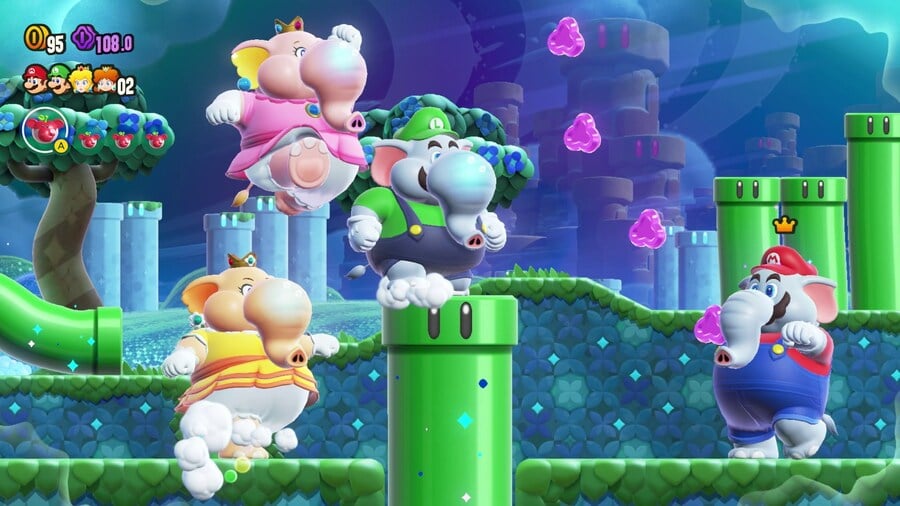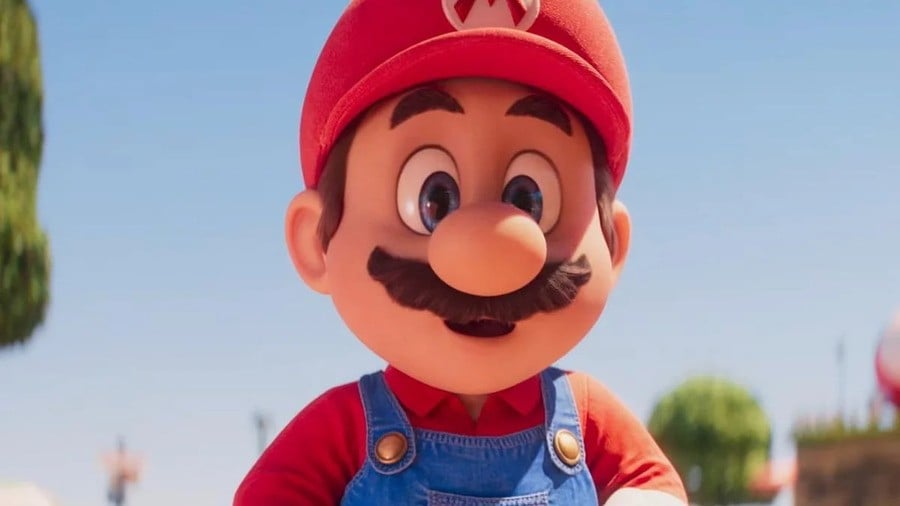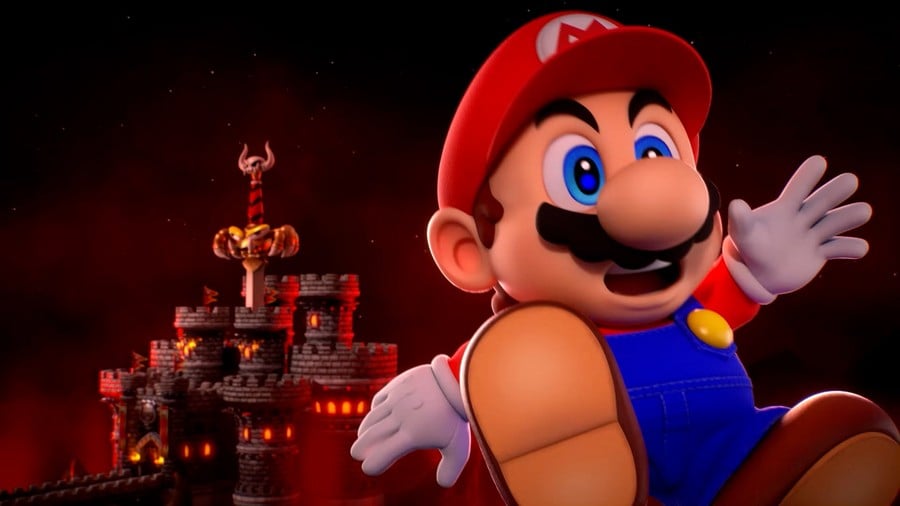It may be no coincidence that Mario’s signature voice actor, Charles Martinet, did not return to lend his talents to the character or his supporting cast in all three major appearances, instead retiring to the role of a Mario Ambassador (whatever that means).
Nintendo seems to have treated 2023 as a very public rebirth for their mascot. The dizzying one-two punch of the Mario movie and the plumber’s return to 2D platforming, plus the finishing blow of Mario RPG, signified a clean break from decades of meticulous visual design and characterization standards. Yes, Mario still says “Wahoo!” and wears his trademark overalls and gloves—that may never change. But Chris Pratt’s performance in the animated film gave Mario a flatter, much less exaggerated voice, pulled from somewhere far removed from Martinet’s take on the character. And though Kevin Afghani does an admirable job in the role for Wonder, the game itself imbues Mario and company with enough personality to make the New Super Mario Bros. series look downright wooden.
[Nintendo] is willing to take a risk on perhaps the most recognizable video game character in the world, trusting that no matter his voice, height, or attitude, audiences will still know who he is.
Wonder doesn’t even take place in the Mushroom Kingdom. Instead, it brings Mario’s merry gang to the Flower Kingdom, where aptly named Wonder Flowers feature in every stage. These items flip each level on its head, enabling characters to stretch to ridiculous heights, transform into Goombas for stealth missions, or turn to slime to squeeze into narrow passages. But some Wonder Flowers will transform the level itself, sometimes changing the perspective from side-on to top-down, or turning the entire affair into a musical. You can even equip badges that alter the game further, from allowing Mario to float through the air to turning him invisible.
And Wonder’s art style and animations reflect this ‘anything goes’ vibe perfectly, with an almost claymation-like aesthetic and designs that hew much closer to Yōichi Kotabe’s original hand-drawn character art. Mario wears a determined expression when he runs, switching stances just at the touch of the dash button, while his feet smear cartoonishly. And for the first time in a 2D Mario game, characters lean nervously on ledges, flailing their arms so they don’t lose balance.
Even the sound profile is totally reimagined. Jumps and power-ups are signaled by warm and familiar instrument sounds like guitar strings and vibraphones, as opposed to the more harsh chiptune-ish sound effects of the New Super Mario Bros. series.

It feels fresh now, but we’ve seen such wild creativity before. Mario may be a product of the 1980s, but even in the ‘90s, Nintendo was still playing around with him. And it wasn’t afraid to let other teams take a crack at it, either. Super Mario Land for the Game Boy was created under the guidance of Metroid producer and Game Boy designer Gunpei Yokoi’s R&D1 rather than Mario mainstay Shigeru Miyamoto and R&D4, and it took a funhouse mirror to what were then relatively new conventions of the series. In Mario Land, aptly named Bombshell Koopas explode when jumped on, shoot-’em-up levels punctuate the action, and the final boss is an alien. That ‘89 game seemed to set a precedent for Mario in the following decade, freeing him to go anywhere and do anything he wanted. Soon, he was a doctor, a go-kart racer, and a party host.
But outside of office walls, things got stranger still. Nintendo was much more liberal with their licensing during the Super Nintendo era, forging partnerships with edutainment companies, Philips and their CD-i console, and letting third-party developers like Rare and Square flesh out Mario’s world. This was often a roll of the dice—1994 alone featured both the wildly successful Donkey Kong Country and the wet thud of Hotel Mario.
Mario’s wibbly-wobbly portrayals in games like Mario Teaches Typing seem just a bit off by today’s standards, and sometimes even the subject matter seemed to drift far into the uncanny. In the case of Mario’s Time Machine, our brave hero travels across the ages to return historical artifacts stolen by Bowser, leading to the amusing fact that both Abraham Lincoln and Mahatma Gandhi necessitate full pages on the Super Mario Wiki.

Mario mania, of course, also extended to the worlds of TV and film, resulting in a trio of DIC Entertainment animated series and the infamous Super Mario Bros. film, starring Bob Hoskins, John Leguizamo, and Dennis Hopper. The film, which features Yoshi getting stabbed in the throat, bears little resemblance to the games upon which it’s based. There’s a reason Nintendo waited 30 years to try adapting Super Mario to the big screen again, and why it sought so much creative control this time around.
But while Nintendo saw its share of flops through its various partnerships and licensing deals, the company’s willingness to explore what Mario could be as a mascot character helped shape him into the affable everyman that he’s known as today.
Miyamoto has referred to Mario and his friends as actors playing roles—not unlike Mickey Mouse. And Mickey, in a very similar way, was also a rougher character in his early days. He was more of a mischievous rascal in the 1920s and ‘30s, thrown into different costumes and roles as the story dictated. Soon enough, Disney straightened him out and cleaned him up to make the universally recognized mouse we all know, and that’s exactly what Nintendo did with Mario in the 2000s.
Across Super Mario Sunshine, Super Mario Galaxy, and the New Super Mario Bros. series, Mario’s proportions, mannerisms, voice, and attitude were all standardized in his games and promotional artwork (with some exceptions, like the stylized Paper Mario and Mario & Luigi series). Gone were the cartoons, film aspirations, and educational PC games. Mario would appear exclusively on Nintendo hardware—a streak that went unbroken until 2016, when Super Mario Run launched on iOS. From there, the gates began to slowly reopen, most notably when Nintendo partnered with Ubisoft for Mario + Rabbids Kingdom Battle.

But even in Kingdom Battle, Mario’s image is carefully curated to be consistent with Nintendo’s portrayal of the character (despite all the gunplay). The animated Mario movie and Wonder—which was arguably influenced somewhat by the Illumination film—plus Mario RPG, represent Nintendo at its most confident and daring. It’s willing to take a risk on perhaps the most recognizable video game character in the world, trusting that no matter his voice, height, or attitude, audiences will still know who he is.
2023 may change the way we see Mario for years to come. Much like Mickey—who had a similar character design overhaul and revival in an Emmy Award-winning series—the plumber still has a lot of life in him. Here’s to a weirder, wackier, wilder Mario in 2024.

Laura Adams is a tech enthusiast residing in the UK. Her articles cover the latest technological innovations, from AI to consumer gadgets, providing readers with a glimpse into the future of technology.








